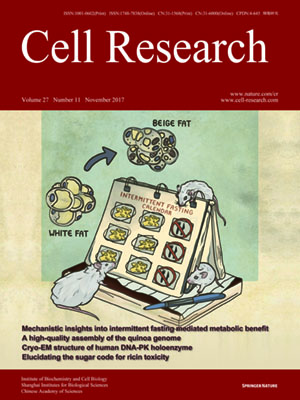
Volume 27, No 11, Nov 2017
ISSN: 1001-0602
EISSN: 1748-7838 2018
impact factor 17.848*
(Clarivate Analytics, 2019)
Volume 27 Issue 11, November 2017: 1351-1364 | Open Access
ORIGINAL ARTICLES
A vital sugar code for ricin toxicity
Jasmin Taubenschmid1,*, Johannes Stadlmann1,*, Markus Jost2, Tove Irene Klokk3, Cory D Rillahan4, Andreas Leibbrandt1, Karl Mechtler1, James C Paulson4, Julian Jude5, Johannes Zuber5, Kirsten Sandvig3,6, Ulrich Elling1, Thorsten Marquardt7, Christian Thiel2, Christian Koerner2 and Josef M Penninger1
1IMBA, Institute of Molecular Biotechnology of the Austrian Academy of Sciences, VBC – Vienna BioCenter Campus, Dr. Bohr-Gasse 3, 1030 Vienna, Austria
2Universitätsklinikum Heidelberg, Zentrum für Kinder- und Jugendmedizin, Analysezentrum III, Klinik für Kinderheilkunde I, Im Neuenheimer Feld 669, 69120 Heidelberg, Germany
3Department of Molecular Cell Biology and Centre for Cancer Biomedicine, Institute for Cancer Research, The Norwegian Radium Hospital, Oslo University Hospital, Montebello, 0379 Oslo, Norway
4Departments of Cell and Molecular Biology, Chemical Physiology, and Immunology and Microbial Science, The Scripps Research Institute, La Jolla, CA 92037, USA
5Institute of Molecular Pathology (IMP), Campus-Vienna-Biocenter 1, 1030 Vienna, Austria
6Department of Biosciences, University of Oslo, 0316 Oslo, Norway
7Universitätsklinikum Münster, Klinik für Kinderheilkunde, Albert-Schweitzer-Campus 1, 48149 Münster, Germany
Correspondence: Josef M Penninger,(josef.penninger@imba.oeaw.ac.at)
Ricin is one of the most feared bioweapons in the world due to its extreme toxicity and easy access. Since no antidote exists, it is of paramount importance to identify the pathways underlying ricin toxicity. Here, we demonstrate that the Golgi GDP-fucose transporter Slc35c1 and fucosyltransferase Fut9 are key regulators of ricin toxicity. Genetic and pharmacological inhibition of fucosylation renders diverse cell types resistant to ricin via deregulated intracellular trafficking. Importantly, cells from a patient with SLC35C1 deficiency are also resistant to ricin. Mechanistically, we confirm that reduced fucosylation leads to increased sialylation of Lewis X structures and thus masking of ricin-binding sites. Inactivation of the sialyltransferase responsible for modifications of Lewis X (St3Gal4) increases the sensitivity of cells to ricin, whereas its overexpression renders cells more resistant to the toxin. Thus, we have provided unprecedented insights into an evolutionary conserved modular sugar code that can be manipulated to control ricin toxicity.
10.1038/cr.2017.116
FULL TEXT | PDF
Browse 2341


